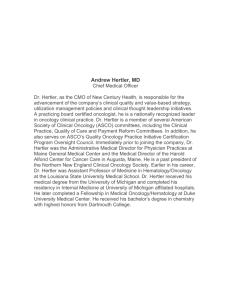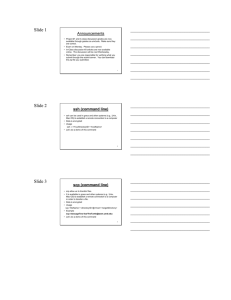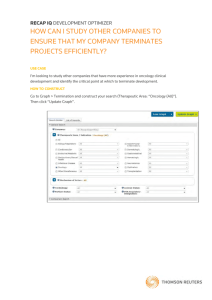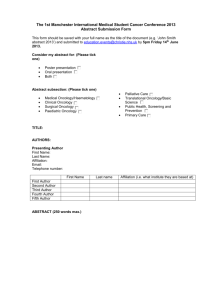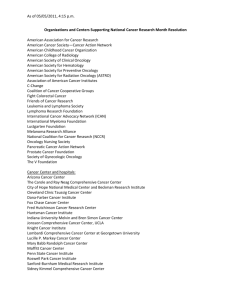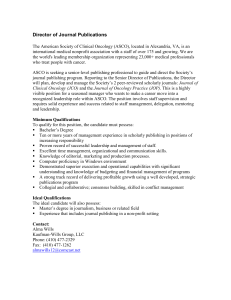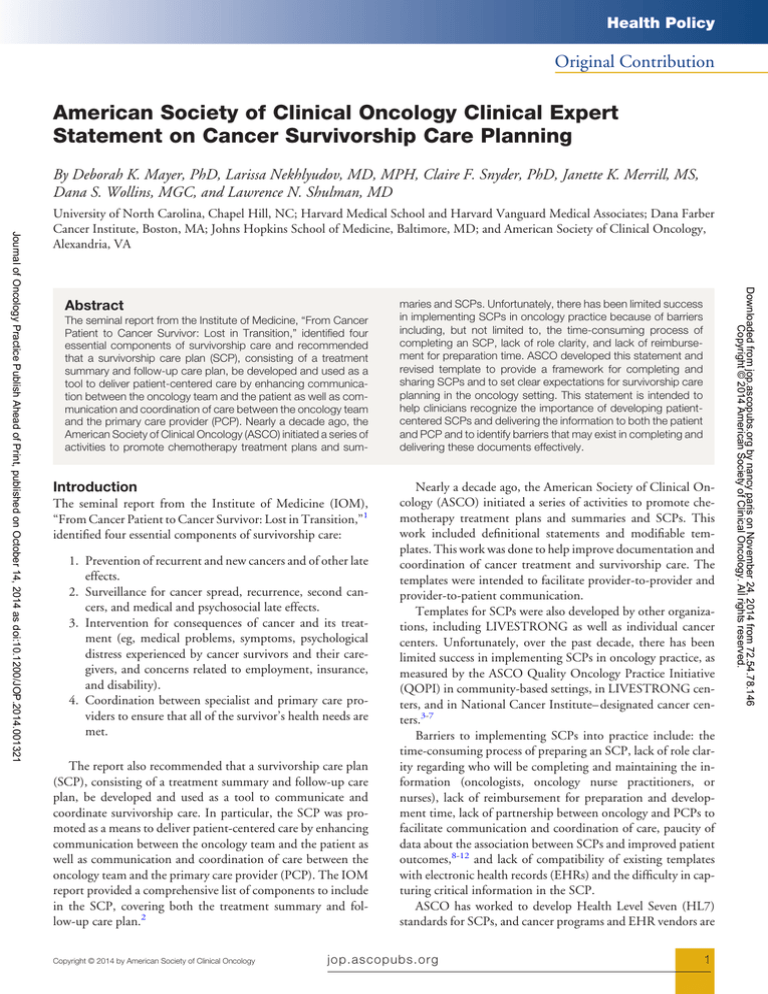
Health Policy
Original Contribution
American Society of Clinical Oncology Clinical Expert
Statement on Cancer Survivorship Care Planning
By Deborah K. Mayer, PhD, Larissa Nekhlyudov, MD, MPH, Claire F. Snyder, PhD, Janette K. Merrill, MS,
Dana S. Wollins, MGC, and Lawrence N. Shulman, MD
Abstract
The seminal report from the Institute of Medicine, “From Cancer
Patient to Cancer Survivor: Lost in Transition,” identified four
essential components of survivorship care and recommended
that a survivorship care plan (SCP), consisting of a treatment
summary and follow-up care plan, be developed and used as a
tool to deliver patient-centered care by enhancing communication between the oncology team and the patient as well as communication and coordination of care between the oncology team
and the primary care provider (PCP). Nearly a decade ago, the
American Society of Clinical Oncology (ASCO) initiated a series of
activities to promote chemotherapy treatment plans and sum-
Introduction
The seminal report from the Institute of Medicine (IOM),
“From Cancer Patient to Cancer Survivor: Lost in Transition,”1
identified four essential components of survivorship care:
1. Prevention of recurrent and new cancers and of other late
effects.
2. Surveillance for cancer spread, recurrence, second cancers, and medical and psychosocial late effects.
3. Intervention for consequences of cancer and its treatment (eg, medical problems, symptoms, psychological
distress experienced by cancer survivors and their caregivers, and concerns related to employment, insurance,
and disability).
4. Coordination between specialist and primary care providers to ensure that all of the survivor’s health needs are
met.
The report also recommended that a survivorship care plan
(SCP), consisting of a treatment summary and follow-up care
plan, be developed and used as a tool to communicate and
coordinate survivorship care. In particular, the SCP was promoted as a means to deliver patient-centered care by enhancing
communication between the oncology team and the patient as
well as communication and coordination of care between the
oncology team and the primary care provider (PCP). The IOM
report provided a comprehensive list of components to include
in the SCP, covering both the treatment summary and follow-up care plan.2
Copyright © 2014 by American Society of Clinical Oncology
maries and SCPs. Unfortunately, there has been limited success
in implementing SCPs in oncology practice because of barriers
including, but not limited to, the time-consuming process of
completing an SCP, lack of role clarity, and lack of reimbursement for preparation time. ASCO developed this statement and
revised template to provide a framework for completing and
sharing SCPs and to set clear expectations for survivorship care
planning in the oncology setting. This statement is intended to
help clinicians recognize the importance of developing patientcentered SCPs and delivering the information to both the patient
and PCP and to identify barriers that may exist in completing and
delivering these documents effectively.
Nearly a decade ago, the American Society of Clinical Oncology (ASCO) initiated a series of activities to promote chemotherapy treatment plans and summaries and SCPs. This
work included definitional statements and modifiable templates. This work was done to help improve documentation and
coordination of cancer treatment and survivorship care. The
templates were intended to facilitate provider-to-provider and
provider-to-patient communication.
Templates for SCPs were also developed by other organizations, including LIVESTRONG as well as individual cancer
centers. Unfortunately, over the past decade, there has been
limited success in implementing SCPs in oncology practice, as
measured by the ASCO Quality Oncology Practice Initiative
(QOPI) in community-based settings, in LIVESTRONG centers, and in National Cancer Institute– designated cancer centers.3-7
Barriers to implementing SCPs into practice include: the
time-consuming process of preparing an SCP, lack of role clarity regarding who will be completing and maintaining the information (oncologists, oncology nurse practitioners, or
nurses), lack of reimbursement for preparation and development time, lack of partnership between oncology and PCPs to
facilitate communication and coordination of care, paucity of
data about the association between SCPs and improved patient
outcomes,8-12 and lack of compatibility of existing templates
with electronic health records (EHRs) and the difficulty in capturing critical information in the SCP.
ASCO has worked to develop Health Level Seven (HL7)
standards for SCPs, and cancer programs and EHR vendors are
jop.ascopubs.org
1
Downloaded from jop.ascopubs.org by nancy paris on November 24, 2014 from 72.54.78.146
Copyright © 2014 American Society of Clinical Oncology. All rights reserved.
Journal of Oncology Practice Publish Ahead of Print, published on October 14, 2014 as doi:10.1200/JOP.2014.001321
University of North Carolina, Chapel Hill, NC; Harvard Medical School and Harvard Vanguard Medical Associates; Dana Farber
Cancer Institute, Boston, MA; Johns Hopkins School of Medicine, Baltimore, MD; and American Society of Clinical Oncology,
Alexandria, VA
Mayer et al
documents. To develop the questionnaire, the workgroup drew
from the IOM standards for SCPs as well as the ASCO generic
treatment plan and summary template. To identify barriers that
may exist for completing and delivering these documents effectively, additional questions were added for the oncology respondents to rate the feasibility of completing each of these
items in practice. The goal of the questionnaire exercise was to
inform discussion at the in-person conference by assembling a
prioritized list regarding which elements respondents felt were
essential in an SCP and the feasibility of collecting these data in
practice. The questionnaire was circulated to stakeholder
groups beyond the conference participants to ensure broad and
varied input to support the discussions. In total, 301 complete
responses were received; the demographics of respondents are
listed in the Data Supplement. Participants were provided with
the summary results of the questionnaire at the conference
(Data Supplement).
To promote productive discussion, meeting participants
were assigned to three breakout groups; each breakout group
included members representing a variety of stakeholder groups
(eg, medical oncology, radiation oncology, primary care, and
survivors). Each group was asked to determine which data elements it felt were essential to an SCP (with separate discussions
for treatment summary and follow-up care plans). Additionally,
barriers were documented. These group discussions accepted
the assumptions outlined in Table 1 when making decisions
about inclusion of key components in an SCP. The results from
each breakout group were reported to the general session, and
areas of disagreement were discussed until consensus was obtained.
Methods
In 2012, ASCO established a joint workgroup of the Cancer
Survivorship Committee and the Quality of Care Committee
to develop a strategy for improving the practice of survivorship
care planning in oncology practice. First, the Survivorship Care
Planning Workgroup reviewed existing literature regarding the
implementation of SCPs in practice. The results of this review
and the discussions of the committees suggested the need for a
shorter, simpler SCP template. Thus, the workgroup undertook an initiative to identify the essential components for an
SCP that addresses the needs of key stakeholders. A survey was
developed and fielded to practicing oncology and primary care
clinicians and patients. Finally, a multistakeholder consensus
conference was convened in September 2013, with the goal of
revisiting the IOM-recommended SCP components and the
original ASCO templates, to determine the minimum key components needed in an SCP. The assumption for this was that
including only minimal key components would facilitate completion of these documents. Participants at the conference represented a variety of stakeholder groups, including medical,
surgical, and radiation oncologists, oncology nurses, PCPs, patient navigators, social workers, cancer survivors, oncology
practice administrators, and insurers.
Before the conference, each participant was asked to complete a questionnaire to rate the importance of specific items for
inclusion in the treatment summary and follow-up care plan
2
JOURNAL
OF
Table 1. Key Assumptions Regarding Intent of SCP Agreed on
by Participants
Key Assumption
The SCP is a two-part tool, a treatment summary and care plan, intended
to facilitate communication and coordination of care between the
patient, oncology providers, primary care providers, and other
providers.
The SCP does not replace discussions but rather is an adjunct to those
discussions. The SCP should be given to the patient, but delivery of an
SCP without discussion is not desirable. This discussion should occur
between the oncology provider and patient at the conclusion of acute
treatment. The SCP should also be delivered to the patient’s PCP and
any other key health care providers.
The SCP should be as simple, clear, and understandable as possible to
meet the needs of the intended users; if actions are identified, the SCP
should include who is primarily responsible.
The SCP is not intended to be or replace the medical record; detailed
original source documentation may be needed by providers for clinical
care.
The SCP developed in this process is intended for patients treated with
curative intent for adult cancers regardless of tumor type. Future
development of SCPs intended for other patients (eg, survivors with
advanced cancer) is needed.
The SCP developed in this process is intended to be presented to
patients who have completed active therapy and have no evidence of
disease; survivors may be on maintenance or ongoing therapy (eg,
hormonal therapy) beyond the acute treatment period.
The SCP can be an evolving document in that it may be updated and
reissued as needed. It may not always be developed and/or presented
in an electronic format, but its documentation should be included in the
survivor’s medical record along with a copy sent to the primary care
provider.
Abbreviation: SCP, survivorship care plan.
ONCOLOGY PRACTICE
Copyright © 2014 by American Society of Clinical Oncology
Downloaded from jop.ascopubs.org by nancy paris on November 24, 2014 from 72.54.78.146
Copyright © 2014 American Society of Clinical Oncology. All rights reserved.
developing EHR functionality to address survivorship care.
However, consistent implementation may be years away for
many settings, and oncology providers are struggling to implement SCPs in practice now. The difficulty of implementing
SCPs in practice has become more of a concern for clinicians,
given the American College of Surgeons Commission on Cancer proposed standard 3.3 (scheduled to begin implementation
in 2015), requiring that “the cancer care committee develops
and implements a process to disseminate a comprehensive care
summary & follow-up plan to patients with cancer completing
cancer treatment.”13(p78)
To address this need, ASCO developed this clinical expert
statement to define the minimum essential elements needed in
an SCP and to identify current barriers to using an SCP and
provide feasible solutions for overcoming these barriers. To
develop this statement, a consensus conference was held in September 2013, and the deliberations from this meeting were used
by the Survivorship Care Planning Workgroup to generate the
recommendations contained herein. This statement defines
the minimum elements needed to complete an SCP that serves
the needs of patients and their families and PCPs caring
for those survivors after cancer treatment. We acknowledge the
importance of other data elements of interest to treating oncologists and researchers that can be captured and communicated
more readily through the EHR, but that is beyond the scope of
our charge and of these recommendations. However, we do
support other EHR capabilities that could be designed for additional purposes to improve survivorship care, quality improvement, and clinical research efforts.
ASCO Expert Statement on Cancer Survivorship Care Planning
Prevention
Early
Detection
Diagnosis
Treatment
Treatment Plan
Survivorship
End-ofLife Care
Survivorship Care Plan
Figure 1. Timing of survivorship care plan delivery.
Results
Treatment Summary
Details regarding the specific dose and fraction for a course
of radiotherapy were not considered to be critical components,
in general. For instance, if the patient were to require irradiation
of the same or adjoining area, the radiation oncologist considering this would need to review the detailed primary records of
the previous radiation therapy. Similarly, chemotherapy agents
should be listed, but details of dosing, dose modification, and
schedule would not be relevant for much of care delivered in the
future. If chemotherapy were considered again in the future, the
Copyright © 2014 by American Society of Clinical Oncology
Table 2. Key Components of Treatment Summary
Key Component
Contact information of the treating institutions and providers
Specific diagnosis (eg, breast cancer), including histologic subtype (eg,
non–small-cell lung cancer) when relevant
Stage of disease at diagnosis (eg, I to III)
Surgery (yes v no); if yes:
Surgical procedure with location on the body
Date of surgery (year required, month optional, day not required)
Chemotherapy (yes v no); if yes:
Names of systemic therapy agents administered (listing individual
names rather than regimens)
End date of chemotherapy treatment (year required, month optional,
day not required)
Radiotherapy (yes v no); if yes:
Anatomic area treated with radiation
End date of radiation treatment (year required, month optional, day
not required)
Ongoing toxicity or adverse effects of all treatments received (including
those resulting from surgery, systemic therapy, and/or
radiotherapy) at the completion of treatment; any information
concerning the likely course of recovery from these toxicities should
also be covered
For selected cancers, genetic or hereditary risk factors or predisposing
conditions and genetic testing results if performed
jop.ascopubs.org
3
Downloaded from jop.ascopubs.org by nancy paris on November 24, 2014 from 72.54.78.146
Copyright © 2014 American Society of Clinical Oncology. All rights reserved.
The treatment summary is the middle of three potentially separate but related documents, temporally occurring between the
treatment plan, which should be given at the time of diagnosis,
and the follow-up care plan, to be delivered at the end of therapy (Figure 1). Although the treatment plan was not addressed
by this workgroup, it sets the stage for the development of the
treatment summary and follow-up care plan included in an
SCP. Specifically, when a patient initiates treatment, a treatment plan should be created by the oncology provider and
include data such as patient demographics, diagnosis and stage
of disease, treatment intent (curative v palliative), and planned
treatment components (chemotherapy, surgery, radiotherapy,
and so on) and duration. The treatment plan would provide a
document to support discussion between the patient and family
and the oncology provider about the planned treatment and
would inform other providers such as the PCP. The data from
the treatment plan would then inform the treatment summary,
although the critical difference is that the treatment summary
would describe what was actually administered to the patient.
Likewise, the treatment summary should inform the follow-up
care plan, because this should be determined by the patient’s
diagnosis, specifics of therapy received, and his or her specific
potential short- and long-term complications and effects.
During the consensus meeting, based on the agreed-on assumptions outlined in Table 1, recommendations were made
about the key components of a treatment summary (Table 2).
Specifically, the group recommended the inclusion of the following components:
1. Contact information for providers and centers who administered the treatment.
2. Basic diagnostic and staging information.
3. Information on surgery, radiation therapy, systemic therapy (both chemotherapy and biologic therapies), and ongoing significant toxicities, including dates (year and
maybe month but not specific days).
medical oncology team would possibly need to review the primary documentation of previous treatment.
Although universal inclusion of tumor grade and nonanatomic staging data was not recommended, inclusion of these
data elements where relevant was advised. Thus, tumor grade is
important to include for specific cancers where it has an impact
on long-term care. Furthermore, nonanatomic staging should
also be included but limited to data that influence treatment
decisions (eg, estrogen receptor status for breast cancer or KRAS
status for colorectal cancer). Because this varies from cancer to
cancer, rather than mandating this for all cancers, extra space
was included on the template. These factors will invariably
change with time as new knowledge becomes available and if
disease-specific templates are developed.
The participants engaged in lengthy discussion regarding
the level of specificity needed regarding dates of diagnosis and
treatment. Arguments centered on the degree to which specific
dates would affect the long-term care of the survivor. Ultimately, it was decided that recording the year of diagnosis was
essential, with month of diagnosis desirable but not required.
Survivors preferred to also include the exact day; however, it was
agreed that knowledge of this would have no impact on treatment or follow-up care and would add to the burden of com-
Mayer et al
Follow-Up Care Plan
The follow-up care plan is meant to aid in the ongoing care of a
cancer survivor by delineating the key components of survivorship care and providing:
1. Surveillance plan to detect recurrence and late adverse
effects.
2. Interventions to manage ongoing problems resulting
from the cancer and its treatment.
3. Age- and sex-appropriate health care, including cancer
screening.
4. General health promotion.
During the consensus meeting, the group reviewed the
IOM-recommended elements and reached consensus on items
to include in the follow-up care plan (Table 3). Although many
patients who have completed treatment may no longer be cared
for in a facility, inclusion of the contact information for the
oncology team members and location of the treatment facility is
important should questions arise about the specifics of the treatment (eg, schedule and dosing of chemotherapy actually administered, doses, and fields of radiation, among others). This
information may then be obtained from the original medical
record available at the treating institution if needed.
Because many patients continue to undergo treatment (eg,
adjuvant hormonal therapy for breast or prostate cancer) after
completion of acute treatment (ie, surgery, chemotherapy, or
radiation therapy), the group recommended that the follow-up
plan include whether such ongoing therapy is advised, how long
the therapy should continue, and what adverse effects may be
4
JOURNAL
OF
Table 3. Key Components of Follow-Up Care Plan
Key Component
Oncology team member contacts with location of the treatment facility
(repeat if separate document)
Need for ongoing adjuvant therapy for cancer
Adjuvant therapy name
Planned duration
Expected adverse effects
Schedule of follow-up–related clinical visits (to be presented in table
format to include who will provide follow-up visits and how often
and where these will take place)
Cancer surveillance tests for recurrence (to be presented in table
format to include who is responsible for ordering or carrying out the
tests, the frequency of testing, and where these will take place)
Cancer screening for early detection of new primaries; to be included
only if different from the general population (presented in table
format to include who is responsible for carrying out tests, the
frequency of testing, and where these will take place)
Other periodic testing and examinations (rather than outlining specific
testing, the group suggested an inclusion of a general statement to
“continue all standard non–cancer-related health care with your
primary care provider, with the following exceptions: [if there are
any]”)
Possible symptoms of cancer recurrence (rather than including a list of
possible symptoms, the group suggested inclusion of a general
statement: “Any new, unusual, and/or persistent symptoms should
be brought to the attention of your provider”)
A list of likely or rare but clinically significant late and/or long-term
effects that a survivor may experience based on his or her individual
diagnosis and treatment if known (including symptoms that may
indicate the presence of such conditions)
A list of items (eg, emotional or mental health, parenting,
work/employment, financial issues, and insurance) should be
covered with standard language stating that survivors have
experienced issues in these areas and that the patient should speak
with his or her oncologist and/or PCP if having related concerns;
include a list of local and national resources to assist the patient in
obtaining proper services
A general statement emphasizing the importance of healthy diet,
exercise, smoking cessation, and alcohol use reduction may be
included; statements may be tailored if particularly pertinent to the
individual
Abbreviation: PCP, primary care provider.
expected. This information is important for both survivor and
PCP education about follow-up care.
The group also recommended that the follow-up care plan
include a schedule of clinical visits and suggested that this may
be achieved in a table format (including who will provide the
visit, where this visit will take place, and what will need to occur
at this visit) to prevent too frequent or infrequent visits. The
logistics for the follow-up visits must be developed in discussions with survivors and tailored to their needs, geographic
locations, and other specifics. Likewise, the group recommended that evidence-based cancer surveillance testing for recurrence should also be included in a table format, outlining
who is responsible for ordering or carrying out the test, how
often and when the testing should occur, and where this will
take place to avoid over- or undertesting. Finally, a similar
recommendation was made to include cancer screening for new
primary cancers, particularly if there was deviation from the
general population guidelines (eg, early breast cancer screening
for women who underwent chest irradiation for Hodgkin lymphoma). Inclusion of routine screening recommendations that
are not different from the general population was not advised.
ONCOLOGY PRACTICE
Copyright © 2014 by American Society of Clinical Oncology
Downloaded from jop.ascopubs.org by nancy paris on November 24, 2014 from 72.54.78.146
Copyright © 2014 American Society of Clinical Oncology. All rights reserved.
pleting the treatment summary. Similar discussions ensured
regarding whether to include specific dates of surgery as well as
the start and end dates of chemotherapy and radiotherapy. Participants agreed that knowing the year in which these interventions took place was essential and including the month was
desired. However, it was noted that having a diagnosis in December of one year and not having a procedure until January of
the next year could be misleading if month was not included. It
was felt that including the end date of each treatment was essential to include but the start date would have no impact on
follow-up care.
Participants agreed it was important to include an active yes
or no regarding whether surgery, chemotherapy, and/or radiotherapy were received by the patient to avoid the appearance
that the information was missed or left out. Participants also
agreed to combine surgical procedure and location into one
element based on the assumption that surgical procedure would
also define the location. Osteoporosis prevention, fertility, and
sexual function were considered to be relevant if they were
specifically associated with late and/or long-term effects of chemotherapy, radiation therapy, or surgery. Therefore, they
should be addressed in the ongoing issues section when relevant. There was agreement that there should be a genetics section for predisposing conditions, to include any counseling or
genetic testing received and results of testing and any relevant
recommendations.
ASCO Expert Statement on Cancer Survivorship Care Planning
Barriers to SCP Implementation
During the consensus meeting, the group discussed various
barriers to implementation and how they might be overcome.
The barriers included:
1. The substantial time required to complete an SCP.
2. Inadequate reimbursement for the time and resources
required to complete the SCP.
3. Challenges in coordinating care among providers and
between providers and survivors.
4. Incomplete penetration of EHR systems in the marketplace that can facilitate SCP completion.
Copyright © 2014 by American Society of Clinical Oncology
Here, we briefly describe these issues and outline an agenda
for evaluating the effectiveness of the revised SCP templates in
addressing these barriers.
Time, resources, and reimbursement. Three of the major obstacles to adoption of SCPs have been the substantial time needed
to complete the documents, the level of detail required, which
substantially effects the time needed for completion, and the
lack of reimbursement for completing the SCP, needed to support this effort.
Even if there are incremental reimbursements for a survivorship visit, if the SCP takes too long to complete, it will be
impractical in the context of most busy oncology practices.
Thus, the ASCO consensus meeting focused specifically on
identifying the elements of SCPs that are both essential and
feasible to collect. The resulting recommendations include substantially less detail than in the original ASCO templates. Importantly, the group agreed that the SCP document alone
would not be sufficient to address the many and varied concerns
or unmet needs that survivors have. ASCO and other organizations could develop resource toolkits for survivors as supplements to the information provided in the SCP.
Coordination among providers. A number of other barriers to
survivorship care planning relate to coordination of care between and among providers, both cancer specialists and PCPs,
as well as with survivors.14 Survivors are often left to navigate
the SCP process on their own, and many do not have the ability
to comprehend or advocate for the directives included. Furthermore, survivors may not have maintained or even had an established relationship with a PCP before or after their cancer
diagnosis. Identifying or establishing a PCP at the time of diagnosis would facilitate this activity at the end of treatment. It
will also be critical for organizations, cancer providers, and
PCPs to establish effective SCP processes.
First, systems and processes are needed to coordinate collection of the relevant data from the multiple providers who
may have been involved in delivering the cancer care (eg,
medical oncology, radiation oncology, and surgery). Second,
completed SCPs are only effective if they are distributed to
and followed by the appropriate providers. A lack of integration, whether electronic or otherwise, between the PCP and
oncology team could make communication of the SCP more
difficult. There is a need to more clearly define not only who
is responsible for completing and delivering the SCP but also
which provider is responsible for following up on identified
needs; this is especially important if care is received at different facilities. Thus, buy-in by the PCPs and other providers, at an individual and organizational level, is required if
they are to take responsibility for aspects of follow-up. This
buy-in may be encouraged through education of PCPs and
other nononcology providers on the value and use of the
SCP document. Cancer programs should also have relationships with PCPs to make referrals for those survivors who do
not have a PCP. Survivors should be aware of the details for
follow-up care using the SCP.
jop.ascopubs.org
5
Downloaded from jop.ascopubs.org by nancy paris on November 24, 2014 from 72.54.78.146
Copyright © 2014 American Society of Clinical Oncology. All rights reserved.
The group did not recommend the inclusion of itemized periodic testing and examinations that are standard of care for all
patients. Rather, the group suggested including a general statement to “continue all standard non– cancer-related health care
with your primary care provider.” The group did not recommend the inclusion of specific lifestyle or health promotion
elements in the SCP. However, a general statement regarding
exercise, nutrition, smoking, and alcohol use may be included
(and tailored specifically to the patient if particularly relevant to
his or her care).
Survivors and their providers are often concerned about recurrence. The group advised against including a comprehensive
list of possible symptoms of cancer recurrence. Rather, the
group suggested that the follow-up plan include a general statement, such as “any new, unusual, and/or persistent symptoms
should be brought to the attention of your provider.” Similarly,
the group advised against including an exhaustive list of late
and/or long-term effects of treatment. Although SCPs are only
as good as the information included, much remains unknown
regarding the late or long-term effects of cancer therapy and
how to address them. More research on these topics is warranted and could be included in the SCP as evidence develops.
To educate survivors and their PCPs, the group suggested that
a focused list of likely and rare but clinically significant effects
be included and personalized to the individual’s treatment
based on available evidence. Any information concerning the
likely course of recovery from toxicities should be covered in the
ongoing toxicity or adverse effects section of the treatment summary (rather than in the follow-up care plan).
Psychosocial effects of cancer treatment can be prominent,
but they also are individual to the survivor. The group suggested
that the follow-up care plan include a statement acknowledging
that survivors often face emotional or mental health, parenting,
work/employment, financial, and/or insurance issues. The
statement should further advise that patients experiencing any
of these issues address them with their oncology and/or PCP.
However, the group noted that although PCPs may be able to
manage many of the psychosocial issues survivors face, they may
not have the resources to address other concerns that may be
best managed by the oncology team. A list of local and national
resources that is developed at individual sites should be provided, as needed.
Mayer et al
The long-term goal for treatment summaries and care plans
is to be largely populated directly from data in the EHR; this is
an important goal that ASCO and other stakeholders will continue to pursue.15 As EHR vendors continue to develop ways to
facilitate the SCP process and to take full advantage of the
functionality of EHRs, we suggest that additional functionality
be built to make the extractable data more comprehensive and
usable to more users. Examples of how an EHR could expand
this functionality include:
1. Surveillance tests, such as laboratory and imaging tests,
could be ordered in advance and on a regular schedule
(CEA every 3 months, computed tomography in 1 year),
with electronic reminder messages sent to the patient
(this feature already is in routine usage in other diseases).
2. Alerts could be sent to providers when a test is overdue.
3. Patients could also enter online their toxicity experiences
and other patient-reported outcomes.
Evaluating Feasibility of Using Revised ASCO SCP
Template in Clinical Practice
The revised SCP template (Data Supplement) was evaluated to
determine whether the modifications decrease the time and
resources required to complete the forms and increase the feasibility of successful implementation. After obtaining institutional review board approval, a pilot study among QOPI
practices was undertaken to test the revised SCP between May
and June 2014. QOPI sites with both high and low rates of SCP
completion were invited to participate. They were given the
new SCP templates and asked to complete them for three to five
patients. A follow-up telephone interview assessed time to completion, along with other information. These assessments included who completed the plans (eg, oncologist, nurse
practitioner, or nurse), how long it took to complete the templates, and any other comments on the clarity of the form. A
6
JOURNAL
OF
Table 4. Pilot Study of Revised SCP Template (N ⫽ 45 SCPs
completed from 11 practice sites)
Scale of 1 (strongly
disagree) to 5
(strongly agree)
Item
Mean
Range
SCP was easy to complete
3.5
1 to 5
Time to complete SCP was reasonable
3.5
1 to 5
Clear what information was needed
3.9
3 to 5
Easy to obtain information for SCP
4.1
2 to 5
Template includes important elements
for SCP
4.5
3 to 5
Information is sufficient for SCP
4.1
3 to 5
Template will be useful in discussing
follow-up care plans
4.7
3 to 5
Average time to complete (range
depended on complexity of
patient’s treatment and familiarity
with the template), minutes
30
10 to 75
Who completed SCP
Nurse practitioner
4
Nurse
3
Nurse with administrator or clerical
personnel
2
Physician
1
Social worker
1
Abbreviation: SCP, survivorship care plan.
total of 45 SCPs were developed and delivered by 11 QOPI
practices. Most practices found this template easier to use than
thepreviousversion.Timetocompletionvariedbasedonpatientcomplexity and familiarity with the form; times averaged 30 minutes, with
a range of 10 to 75 minutes. Practices were asked to rate the SCP on a
scale of 1 (strongly disagree) to 5 (strongly agree). Results (listed in
Table 4) showed the following:
1. The SCP was easy to complete (mean score, 3.5).
2. Time to complete the templates was reasonable (mean
score, 3.5).
3. It was clear what information was needed (mean score,
3.9).
4. It was easy to obtain the information (mean score, 4.1).
5. Overall, the template includes important elements for
survivorship care planning (mean score, 4.5).
6. The information is sufficient for an SCP (mean score,
4.1).
7. The template will be useful in discussing follow-up care
plans (mean score, 4.7).
Although one site found the SCP redundant to a survivor
binder that was given to patients at that practice, a majority of
comments were favorable, and suggestions for improvement
were incorporated into the template.
Discussion
It is important to demonstrate the value of SCPs to survivors,
oncology providers, PCPs, and other providers. Important end
points include improved knowledge of and adherence to appropriate follow-up, better identification and management of long-
ONCOLOGY PRACTICE
Copyright © 2014 by American Society of Clinical Oncology
Downloaded from jop.ascopubs.org by nancy paris on November 24, 2014 from 72.54.78.146
Copyright © 2014 American Society of Clinical Oncology. All rights reserved.
Role of technology. Throughout the discussions, technology in
general, and EHRs in particular, were seen as having great but
unrealized potential to facilitate the SCP process. For example,
automated alerts and reminders can help ensure that SCPs are
completed for and delivered to eligible survivors when treatment ends. Given that the information required in the SCP
may come from multiple providers, centralized information
technology systems through which multiple users can input or
access information can be helpful, greatly facilitating gathering
the necessary information needed to complete the SCP.
Although the group recognized the potential of technology
to facilitate the SCP process, they equally noted that this potential will not be fulfilled until a number of barriers are addressed. These barriers include:
1. Lack of EHR adoption by some providers.
2. Challenges in interoperability across EHR software systems.
3. Limited ability of EHRs to autopopulate treatment summary and SCPs.
4. Difficulty providing plain-language summaries and direction for patients and their PCPs.
ASCO Expert Statement on Cancer Survivorship Care Planning
actions are taken, we may have a better understanding of what
benefit the SCP has in the quality of care for cancer survivors.
Authors’ Disclosures of Potential Conflicts of Interest
Disclosures provided by the authors are available with this article at
jop.ascopubs.org.
Author Contributions
Conception and design: All authors
Administrative support: Janette K. Merrill
Collection and assembly of data: All authors
Data analysis and interpretation: Deborah K. Mayer, Larissa Nekhlyudov, Claire F. Snyder, Lawrence Shulman
Manuscript writing: All authors
Final approval of manuscript: All authors
Corresponding author: Deborah K. Mayer, PhD, UNC Lineberger Comprehensive Cancer Center, Carrington Hall 7460, Chapel Hill, NC
27599; e-mail: dmayer@unc.edu.
Reprint requests: 2318 Mill Road, Suite 800, Alexandria, VA 22314;
cancerpolicy@asco.org.
DOI: 10.1200/JOP.2014.001321; published online ahead of print
at jop.ascopubs.org on October 14, 2014.
References
1. Hewitt M, Greenfield S, Stovall E (eds): From Cancer Patient to Cancer Survivor: Lost in Transition. Washington, DC, National Academies Press, 2005
2. Hewitt M, Ganz P (eds): Implementing Cancer Survivorship Care Planning:
Workshop Summary. Washington, DC, National Academies Press, 2007
3. Birken SA, Deal AM, Mayer DK, et al: Following through: The consistency of
survivorship care plan use in United States cancer programs. J Cancer Educ
[epub ahead of print on February 28, 2014]
4. Birken S, Deal A, Mayer D, et al: Prevalence and barriers to survivorship care
plan use in United States cancer programs. J Cancer Educ [epub ahead of print on
April 6, 2014]
5. Forsythe LP, Parry C, Alfano CM, et al: Gaps in survivorship care plan delivery
and potential benefits to survivorship care. J Clin Oncol 31, 2013 (suppl 15s; abstr
9594)
6. Salz T, Oeffinger KC, McCabe MS, et al: Survivorship care plans in research
and practice. CA Cancer J Clin [epub ahead of print on January 12, 2012]
7. Stricker CT, Jacobs LA, Risendal B, et al: Survivorship care planning after the
Institute of Medicine recommendations: How are we faring? J Cancer Surviv
5:358-370, 2011
8. Howell D, Hack TF, Oliver TK, et al: Survivorship services for adult cancer
populations: A pan-Canadian guideline. Curr Oncol 18:e265-e281, 2011
Copyright © 2014 by American Society of Clinical Oncology
9. Mayer DK, Gerstel A, Walton A, et al: Implementing survivorship care plans
(SCP) for colon cancer survivors in A comprehensive cancer center. Oncol Nurs
Forum 41:266-273, 2014
10. Stricker CT, Jacobs LA, Panzer SL, et al: Breast cancer survivorship visits:
Presenting concerns and resulting recommendations. J Clin Oncol 31, 2013
(suppl 15s; abstr e20553)
11. Stricker CT, Jacobs LA, Risendal B, et al: Survivorship care planning after the
institute of medicine recommendations: How are we faring? J Cancer Surviv
5:358-370, 2011
12. Salz T, McCabe MS, Blinder VS, et al: Colorectal cancer survivors’ needs and
preferences for survivorship information. J Oncol Pract 10:e277-e282, 2014
13. Commission on Cancer: Cancer program standards 2012: Ensuring patientcentered care (version 1.2). http://www.facs.org/cancer/coc/programstandards
2012.pdf
14. Aubin M, Giguère A, Martin M, et al: Interventions to improve continuity of care
in the follow-up of patients with cancer. Cochrane Database Syst Rev
7:CD007672, 2012
15. Yu PP: Oncology in the digital health age. J Oncol Prac 10:227-230, 2014
16. Mayer DK, Birken SA, Check DK, et al: Summing it up: An integrative review
of studies of cancer survivorship care plans (2006-2013). Cancer [epub ahead of
print on September 23, 2014]
17. Parry C, Kent EE, Forsythe LP, et al: Can’t see the forest for the care plan: A
call to revisit the context of care planning. J Clin Oncol 31:2651-2653, 2013
jop.ascopubs.org
7
Downloaded from jop.ascopubs.org by nancy paris on November 24, 2014 from 72.54.78.146
Copyright © 2014 American Society of Clinical Oncology. All rights reserved.
term and late effects, and improved coordination among cancer
and noncancer providers. As EHR technology continues to develop, it will also be useful to complete the template. Once
SCPs are adopted on a wider scale, their value for improving the
process of survivorship care planning should be evaluated, and
other questions regarding improved outcomes can and must be
addressed by well-designed and executed research and implementation studies.12,16,17
The cancer survivorship document is designed to serve the
needs of patients and their families and PCPs. We acknowledge
the importance of other data elements of interest to treating
oncologists and researchers that can be captured and communicated more readily digitally than on paper and that the ASCO
HL7 draft standard clinical oncology treatment plan and summary is designed to capture more robust amounts of data and
flexibly present that data specific to users’ needs, be they patients or physicians or researchers.15
Future studies will be required to determine if there is an
increased uptake of the SCP to ensure that patients and PCPs
are receiving adequate information about the course of care and
to understand what barriers may or may not have been addressed. Furthermore, disease-specific templates and support
tools may be considered for future development. Once these
Mayer et al
AUTHORS’ DISCLOSURES OF POTENTIAL CONFLICTS OF INTEREST
American Society of Clinical Oncology Clinical Expert Statement on Cancer Survivorship Care Planning
The following represents disclosure information provided by authors of this manuscript. All relationships are considered compensated. Relationships
are self-held unless noted. I ⫽ Immediate Family Member, Inst ⫽ My Institution. Relationships may not relate to the subject matter of this manuscript.
For more information about ASCO’s conflict of interest policy, please refer to www.asco.org/rwc or jop.ascopubs.org/site/misc/ifc.xhtml.
Janette K. Merrill
No relationship to disclose
Larissa Nekhlyudov
No relationship to disclose
Dana S. Wollins
No relationship to disclose
Claire F. Snyder
Stock or Other Ownership: Immunomedics, Merck, Oncolytics
Biotech, Express Scripts
Consulting or Advisory Role: Walgreens (Inst)
Research Funding: WellPoint (Inst), Genentech
Lawrence Shulman
No relationship to disclose
JOURNAL
OF
ONCOLOGY PRACTICE
Downloaded from jop.ascopubs.org by nancy paris on November 24, 2014 from 72.54.78.146
Copyright © 2014 American Society of Clinical Oncology. All rights reserved.
Deborah K. Mayer
No relationship to disclose
Copyright © 2014 by American Society of Clinical Oncology

